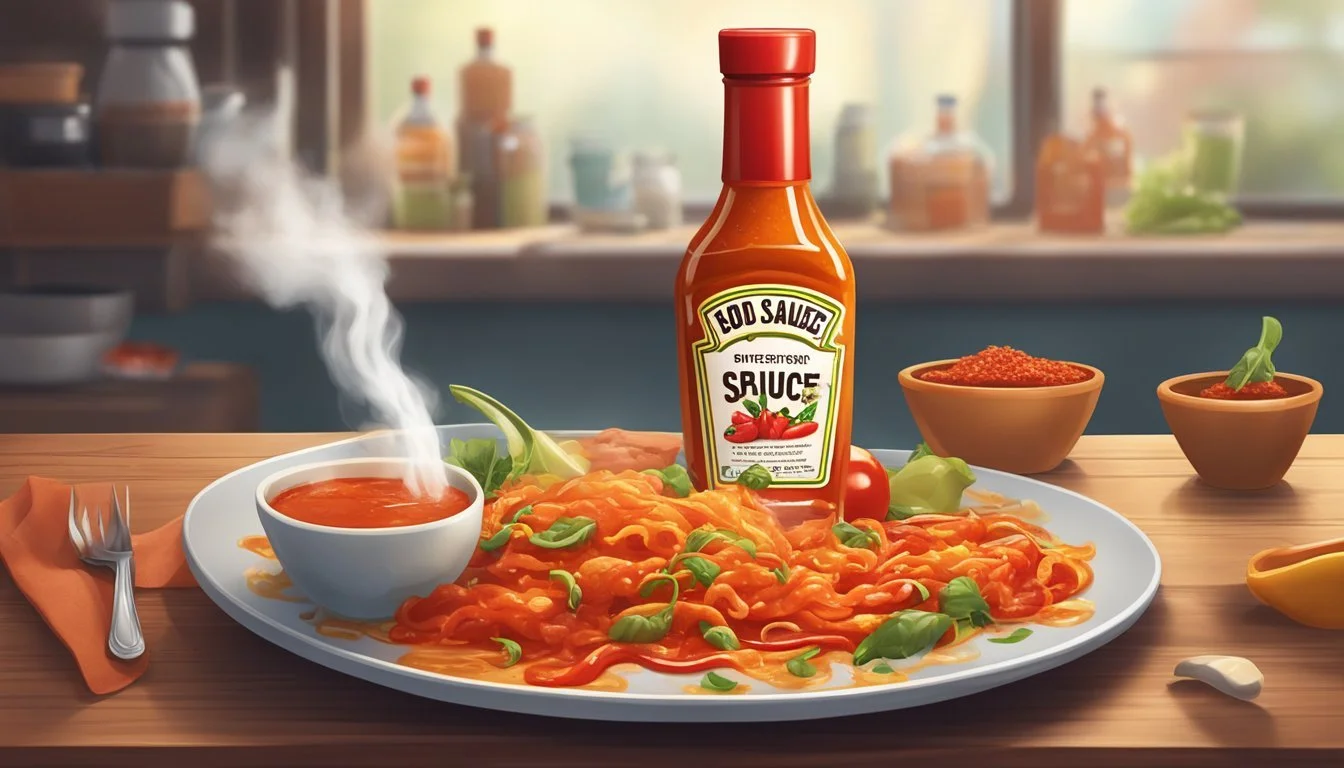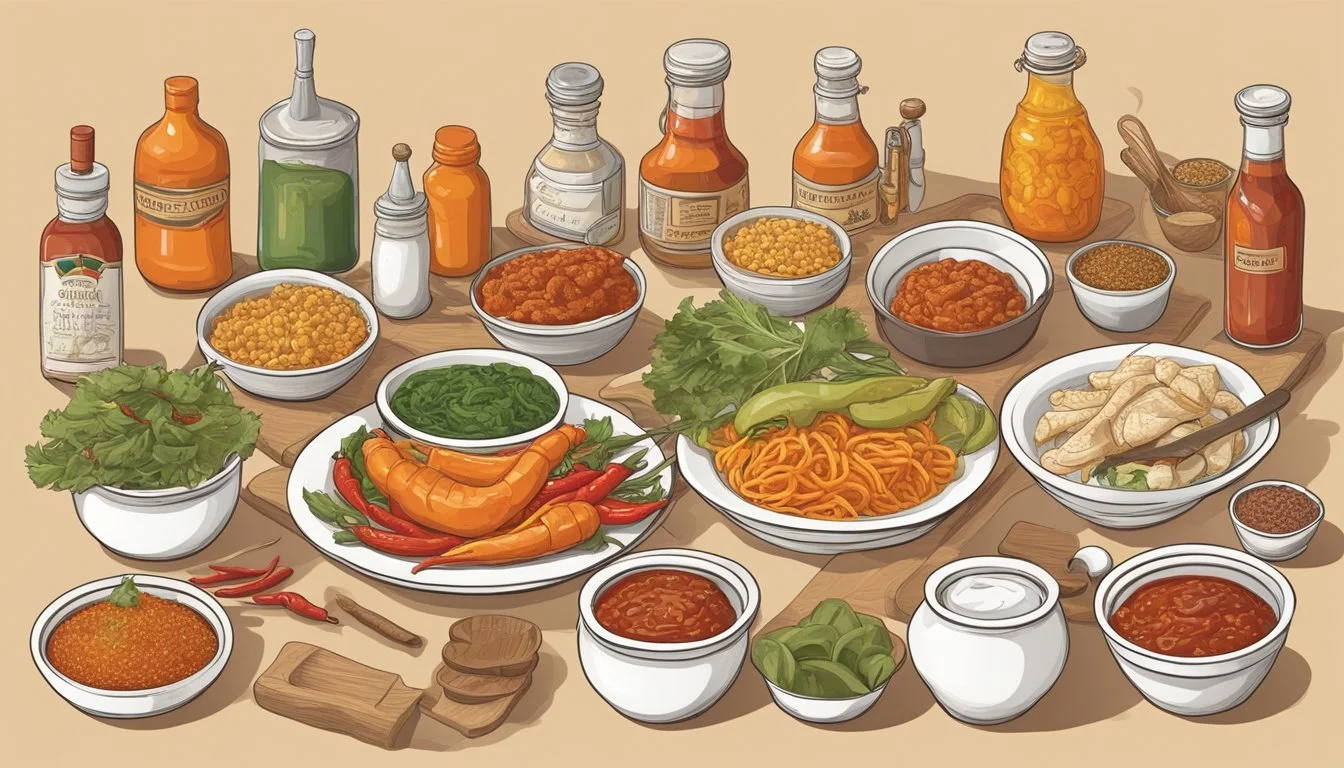Hot Sauce and Digestion
Exploring the Impact of Spicy Foods on Gut Health
The connection between spicy food and digestion has long intrigued both culinary enthusiasts and health professionals. Capsaicin, the compound found in chili peppers that gives them their heat, has been studied for its potential effects on metabolism. Some research indicates that capsaicin may boost metabolic rate, suggesting a possible benefit for digestion by increasing the speed at which the body processes food.
However, the impact of spicy food on digestion is not straightforward. While some individuals may find that moderate consumption of spicy foods aids in digestion and could potentially help alleviate symptoms like constipation, others may experience discomfort. The introduction of spicy foods into one's diet can lead to an increase in gastric mucus production, but it might also cause irritation in the gastrointestinal tract for some, leading to stomach pain or cramping.
Assessing the pros and cons of spicy foods in the context of digestive health is essential. Though hot sauce and similar spicy condiments are popular and can add zest to a meal, their role in digestion varies from person to person. Determining whether spicy foods could facilitate better digestion involves a balance between personal tolerance and understanding the effects of capsaicin and other spicy compounds on the digestive system.
Understanding Capsaicin and Its Role in Digestion
Capsaicin is renowned for imparting heat to peppers and influencing digestion through its interaction with the stomach and pain receptors.
The Chemical Properties of Capsaicin
Capsaicin is a hydrophobic, colorless, odorless compound with the chemical structure 8-methyl-N-vanillyl-6-nonenamide. It is not soluble in water, but it is soluble in alcohol and other organic solvents. Due to its chemical nature, capsaicin remains relatively stable under heat and is the primary component that gives chili peppers their characteristic pungency.
Impact of Capsaicin on the Stomach and GI Tract
When ingested, capsaicin has a noticeable effect on the gastrointestinal (GI) tract. It stimulates gastric secretions and can induce motility. However, in some individuals, consumption could lead to sensations of discomfort such as heartburn. Sensitivity varies significantly among individuals, but in moderate amounts, capsaicin has been reported to facilitate digestive processes.
Capsaicin Interaction with Pain Receptors
Capsaicin binds to the transient receptor potential vanilloid 1 (TRPV1), a pain receptor located on sensory neurons. This interaction initially causes a burning sensation followed by desensitization and a reduction in the sensation of pain. Regular consumption of capsaicin may lead to a long-term decrease in sensitivity to capsaicin's effects due to the desensitization of these pain receptors.
The Heat Factor: Scoville Scale and Different Types of Peppers
The Scoville Scale provides a definitive measurement of the heat level present in chili peppers, ranging from mild bell peppers to the intensely fiery Carolina Reaper.
Scoville Heat Units Explained
The Scoville Heat Units (SHU) are the standard measurement of spiciness or pungency in chili peppers. This unit of measure was introduced by Wilbur Scoville in 1912. It quantifies the concentration of capsaicin, the chemical responsible for the fiery sensation in peppers. Starting with a solution of the pepper extract, the Scoville test checks for the dilution required for the heat to become undetectable to a panel of tasters; the higher the SHU, the hotter the pepper.
Varieties of Chili Peppers and Their Heat Levels
Chili peppers come in a vast array of varieties, each with their own unique SHU rating:
Bell Pepper: 0 SHU, offering no heat, suitable for all pallets.
Jalapeño: 2,500 - 8,000 SHU, a common choice for moderate spiciness.
Cayenne Pepper: Around 30,000 - 50,000 SHU, a sharp spike in heat used widely in cooking.
Ghost Pepper (Bhut Jolokia): Up to 1,041,427 SHU, previously held the record for the world's hottest pepper.
Carolina Reaper: 1,641,183 SHU on average with peaks reportedly over 2,200,000 SHU, currently holds the record for the hottest chili pepper.
These peppers can be used in hot sauces or dishes to add heat. The choice of pepper, and consequently the level of heat, impacts digestion and the overall eating experience.
Health Benefits and Risks of Spicy Foods
Spicy foods are recognized for their potential to enhance metabolism and provide nutritional benefits, yet they can also pose risks such as causing stomach pain or other digestive issues in some individuals.
Nutritional Value of Spicy Foods
Many spicy foods contain capsaicin, the active compound in chili peppers responsible for the heat sensation. Capsaicin is low in calories, without carbs, fat, or protein. Spices themselves, such as cayenne pepper and paprika, can be rich in vitamins like vitamin A, and minerals like potassium and magnesium.
Digestive Health and Spicy Foods
While spicy foods do not cause ulcers as once believed, caution is advised for individuals with irritable bowel syndrome, dyspepsia, or inflammatory bowel disease. For those without these conditions, moderate amounts of spicy food can stimulate digestion and potentially aid in preventing constipation.
Spicy Foods and Weight Management
Research points to capsaicin's ability to boost metabolism, which can be beneficial in weight management. The thermogenic properties of spicy foods may increase energy expenditure and lipid oxidation, thus playing a supportive role in combating obesity.
Potential Dangers and Side Effects
Overconsumption of spicy foods might lead to abdominal pain, burning diarrhea, chest pain, headaches, and vomiting. In extreme cases, capsaicin can lead to significant discomfort, especially if one has pre-existing conditions such as anal fissures where the ingestion of spicy food can exacerbate pain and irritation.
Effects of Spicy Food on Metabolic Functions
Consuming spicy foods may have notable implications on metabolic functions, particularly concerning energy expenditure and fat oxidation, while also potentially influencing appetite and overall consumption habits.
Role in Energy Expenditure and Fat Oxidation
Spicy food is associated with a temporary increase in metabolism as it may boost energy expenditure and fat oxidation. Specific compounds found in spicy foods, like capsaicin, can induce a thermogenic effect, whereby the body burns more calories to produce heat. This process often leads to enhanced fat breakdown, though the overall impact on weight loss may be modest.
Thermogenesis: Capsaicin can raise body temperature, leading to higher energy expenditure.
Fat breakdown: There's evidence suggesting that capsaicin promotes the mobilization and oxidation of fat stores.
Influence on Appetite and Consumption
The impact of spicy food on appetite and consumption is multifaceted. On one hand, capsaicin has been seen to reduce hunger, which may lead to a decrease in calorie intake. On the other hand, the palatability of spicy food for some individuals might increase overall food consumption, countering any potential benefits related to calorie control.
Appetite reduction: Some studies point to capsaicin potentially making people feel fuller, faster.
Calorie intake: Depending on individual tolerance and preference, the enticement of spicy flavors can lead to variable food consumption patterns.
Gastrointestinal Conditions and Spicy Foods
Spicy foods can influence various gastrointestinal conditions, from acid reflux to ulcers and irritable bowel syndrome. Understanding the impact of spicy foods on these conditions is crucial for dietary choices that support digestive health.
Impact on Acid Reflux and GERD
Spicy foods can exacerbate symptoms of acid reflux and gastroesophageal reflux disease (GERD). They may cause the lower esophageal sphincter to relax, permitting stomach acids to flow back up into the esophagus. This can lead to a burning sensation in the chest or throat commonly known as heartburn. Individuals with GERD might find that spicy foods trigger more frequent or intense symptoms.
Spicy Food Consumption and Ulcers
Contrary to popular belief, the consumption of spicy foods is not a direct cause of ulcers. Ulcers are primarily caused by Helicobacter pylori bacteria infections or chronic use of nonsteroidal anti-inflammatory drugs (NSAIDs). However, for those already suffering from ulcers, eating spicy foods can irritate the stomach lining, potentially worsening symptoms and discomfort.
Irritable Bowel Syndrome and Spicy Foods
For those with irritable bowel syndrome (IBS), spicy foods can sometimes trigger symptoms such as stomach pain and diarrhea. The capsaicin in spicy foods may irritate the gut, although individual tolerance can vary greatly. It is recommended that people with IBS monitor their reaction to spicy foods and adjust their intake accordingly.
The Role of Culture and Diet in Spicy Food Consumption
Spicy food consumption varies globally and is deeply intertwined with cultural practices and dietary preferences. Specific spices, like turmeric and cumin, and ingredients such as chile peppers, hold significant cultural value and are essential in various recipes.
Global Patterns of Spicy Food Intake
In many countries, the use of spices and chili peppers in recipes is not solely for flavor enhancement but also for their potential health benefits. Asia and Latin America are regions where spicy food is a staple, partly due to the favorable climate for growing a variety of chile peppers. Diets in these regions often feature turmeric and cumin, which are prominent in Indian and Mexican cuisines, respectively.
In contrast, European diets traditionally include milder flavors, with spices less integral to everyday cuisine. However, globalization has introduced and popularized a range of spices and spicy foods, thus altering some consumption patterns.
Cultural Significance of Spices and Herbs
Spices and herbs carry more than just culinary importance; they are a part of cultural identity and heritage. For instance, turmeric is not only used for cooking but also in traditional ceremonies in India. Similarly, cumin is prevalent in Middle Eastern cultures, not only for its flavor but for its supposed digestive properties.
Chile peppers have a particular place in many cultures, beyond adding heat to foods. They are involved in traditional dishes and communal eating experiences that signify unity and strength. For example, the use of chile peppers in Korean kimchi or in the fiery Sichuan dishes of China underscores the role of spicy food as a dietary staple that reflects communal ties and regional pride.
Scientific Research and Studies on Spicy Foods
Despite the popularity of spicy foods globally, their impact on digestion and overall health has been a subject of scientific investigation. Various studies have focused on how the consumption of spicy foods, often rich in compounds such as capsaicin, relates to health outcomes.
Meta-Analysis of Spicy Food Consumption
Meta-analysis has become a crucial tool in understanding the broader impacts of spicy food consumption on health. A comprehensive meta-analysis examined numerous observational studies to draw substantial conclusions regarding spicy foods and their association with obesity, hypertension, and blood lipid levels. Results imply there is no clear consensus, as relationships between spicy food intake and health conditions like high blood pressure and heart disease often show conflicting outcomes within the research community.
Correlations with Health Outcomes
Specific health outcomes, particularly regarding cardiovascular disease (CVD) and certain types of cancer, have received significant attention in research circles. Notable studies have suggested that high consumption of spicy foods might correlate with a lower risk of some gastrointestinal cancers. Conversely, the association with CVD risk factors appears inconsistent. Some studies indicate potential benefits, whereas others do not establish a strong correlation. These varied findings underscore the complexity of diet's role in health and the need for further research to solidify these associations.
The Influence of Spicy Foods on the Microbiome
Spicy foods may impact the composition and function of the gut microbiome, potentially influencing inflammatory processes within the digestive system.
Effects on Gut Bacteria and Inflammation
Spicy foods, particularly those containing capsaicin—the compound responsible for the heat in chili peppers—have been shown to interact with the gut microbiome. Research indicates that capsaicin may have an anti-inflammatory effect by altering the diversity and population of gut microbiota. Specifically, some studies suggest that spicy compounds promote the growth of beneficial bacteria while inhibiting pathogens that can cause disease. This rebalancing of bacteria may play a role in reducing gut inflammation.
However, the impact of spicy food on gut bacteria can vary widely among individuals. The dietary inclusion of spices, such as ginger, black pepper, and cayenne pepper, has been noted to change the composition of gut bacteria. The responsiveness of the microbiome to these spices underscores the potential of dietary interventions to support digestive health and reduce inflammatory states within the gut.
It's important to note that the degree of influence spicy foods have on gut microbiota and inflammation can be affected by factors such as the amount and frequency of spicy food consumption, individual tolerance levels, and overall dietary patterns. While spicy foods may encourage a healthy gut microbiome and possess anti-inflammatory qualities, moderation is key, and individuals with sensitive digestive systems should approach them with caution.
Effective Ways to Cool Down After Eating Spicy Foods
Upon consuming spicy foods, individuals might experience a strong burning sensation. To mitigate this discomfort, there are several effective methods, primarily involving dairy products, which contain a protein that helps break down the heat-inducing compounds found in spices.
Milk and Dairy as Neutralizing Agents
Milk is renowned for its ability to counteract the burn one feels after eating spicy food. It contains casein, a protein that acts as a natural combatant to capsaicin, the compound responsible for the heat in chili peppers. Unlike water, which merely spreads capsaicin around, casein binds with the spicy molecules and helps to wash them away. For immediate relief, one should opt for a glass of cold milk.
Dairy Alternatives: In addition to milk, other dairy products such as yogurt and ice cream can also offer relief due to their casein content.
Cheese: Consuming cheese, another dairy product rich in casein, may help cool down the burning sensation effectively.
Note: Individuals who are lactose intolerant or vegan might want to consider lactose-free or plant-based milk alternatives that are fortified with casein.
Other Tips to Alleviate Burning Sensation
While dairy is a primary aid, other methods also exist to alleviate the fiery feeling one might experience:
Acidic Solutions: Acidic beverages like lemonade or tomato juice can help neutralize the pH level in the mouth, providing relief from the burn.
Starches: Eating starchy foods such as bread or rice can help as they absorb the capsaicin and can reduce the burning sensation.
Avoid Alcohol: Alcohol can intensify the burning sensation, so it is best avoided when trying to cool down the mouth after spicy foods.
These measures should help in reducing the discomfort associated with the consumption of spicy foods.
Spicy Foods in Medicine and Therapeutic Practices
Spicy foods, particularly those containing capsaicin, have been harnessed both in traditional healing practices and modern medicine due to their analgesic and anti-inflammatory properties.
Traditional Uses of Capsaicin in Healing
In traditional medicine, capsaicin, an active component of chili peppers, has served a pivotal role in therapeutic practices. Indigenous peoples, particularly in the Americas, have utilized capsaicin-rich compounds for managing pain and treating various ailments. They recognized its benefits in reducing inflammation and its ability to act as an antioxidant. Capsaicin has been employed topically for alleviating symptoms of arthritis due to its warming sensation and ensuing pain relief.
Modern Medical Applications of Spicy Compounds
Today, capsaicin is an integral part of modern medical treatments. Its use has been substantiated through scientific research, confirming its effectiveness in pain management and as an anti-inflammatory agent. Capsaicin is now commonly found in topical creams and patches used to treat chronic pain conditions, such as neuropathic pain and osteoarthritis. Researchers have determined that capsaicin works by desensitizing sensory neurons, leading to diminished pain signals. Additionally, its antioxidant properties contribute to its use in medicine for protecting cells against oxidative stress.
Conclusion
The exploration of hot sauce and its role in digestion reveals interesting findings. Evidence indicates that capsaicin, the fiery component of chili peppers featured in hot sauce, may promote metabolic and digestive processes. Regular consumption in moderate quantities can potentially boost metabolism and aid in digestion.
However, individuals with sensitive digestive systems, such as those with irritable bowel syndrome (IBS) or inflammatory bowel disease (IBD), ought to approach spicy foods with caution. Although spicy foods are not the direct cause of ulcers, they can exacerbate symptoms in pre-existing conditions. It is crucial for those with digestive issues to monitor their response to spicy foods.
Capsaicin's ability to trigger endorphins and dopamine also adds a bonus of wellbeing, as these are chemicals associated with pleasure and happiness.
In conclusion, the relationship between hot sauce and digestion underscores the importance of personal dietary tolerance and balance. Those who can tolerate spiciness may enjoy the digestive benefits along with the flavors that spicy foods contribute to a meal. Individuals interested in incorporating more spicy foods into their diet should do so gradually, paying attention to their body's reactions.







